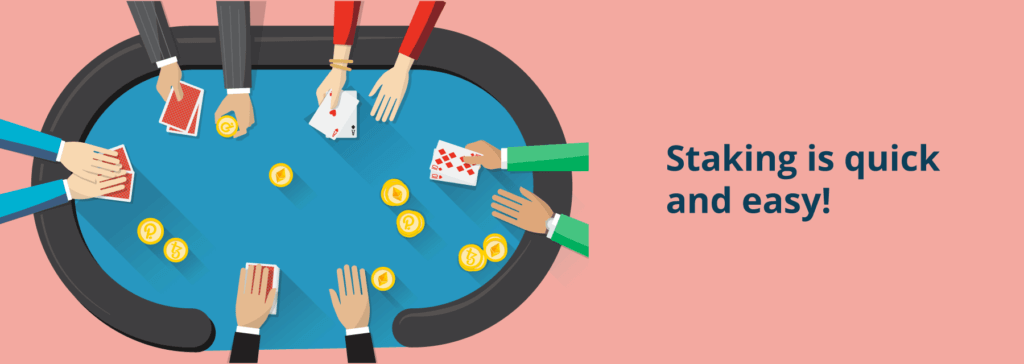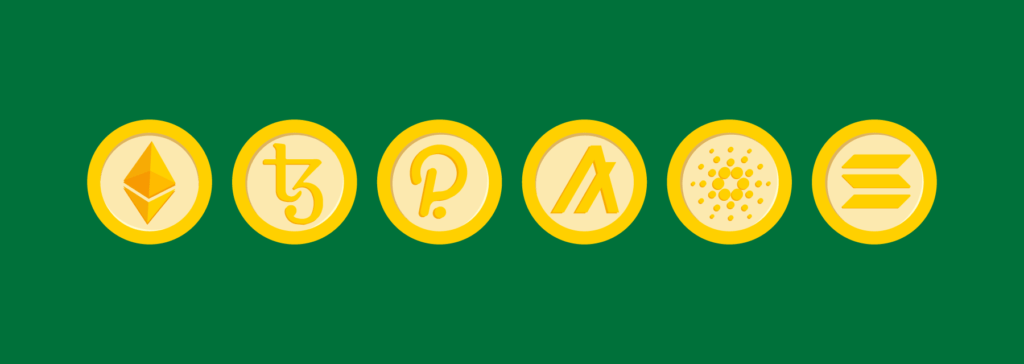The complete guide to staking crypto
Staking can seem like a scary concept, especially given how confusing it can be to set up.
But, with a little bit of time and help, even you can become a staking pro.
We’re going to run you through everything you need to go from novice to staking pro.
Even if you’re already staking crypto, we’re pretty sure that we can teach you a trick or 2 so that you can take your staking game to the next level.
Are you ready to learn about staking crypto?
Let’s go!
What is staking?

Simply put, staking is the term for locking up coins in order to try and validate network transactions.
The more coins that you stake, the more chance you have of being chosen as the next block validator and earning the block rewards.
Staking is used in Proof-of-Stake (PoS) blockchains and other blockchains using modified versions of PoS, such as delegated PoS.
Without people staking coins on a PoS blockchain, consensus woulnd’t be achieved and transactions would stop being processed.
In return, stakers get a block reward for every block they’re involved in validating.
Different PoS blockchains have different reward levels, but it’s a profitable activity.
This is due to the fact that there are no daily costs involved.
You simply lock away your coins and can withdraw them from staking at any time.
The system can be gamed, if you have enough capital to buy a large portion of the coins.
However, bad actors are disincentivized from doing this and damaging the network.
If a staker is caught acting maliciously, the network has the power to repossess all their staked coins.
Staking can be done on any PoS blockchain and comes with a minimum stake requirement.
For example, to stake on Ethereum 2.0, you must have at least 32 ETH in your staking wallet if you wish to stake solo.
You can stake in pools, much like you can mine cryptocurrency in pools.
For this you can use a fraction of an ETH and you’ll get paid based on your ownership percentage of the staked pool.
This amount varies from blockchain to blockchain, with the coin value determining how much that will cost you in fiat money.
How does staking work?

Crypto staking is painted to be a confusing and tricky world, but it’s actually quite simple to do.
First up, you’ll need to pick a cryptocurrency that supports staking.
These are currently just shy of 100 cryptocurrencies that you can stake, and Ethereum 2.0 will take that up a notch once it’s live.
The top cryptos that support staking are:
Each cryptocurrency that supports staking will have a different minimum requirement to get going.
Some, however, will let you stake with a fraction of a single coin, which makes them popular with beginner stakers.
Once you’ve picked a cryptocurrency to stake and you’ve acquired enough to begin either staking alone or in a pool, it’s time to stake.
Each blockchain does this slightly differently, but it results in the same outcome.
For most blockchains, you simply need to download and use a wallet that supports staking for that currency.
Ledger’s wallets support staking out of the box and are a great choice for stakers thanks to the enhanced security of using a hardware wallet.
You then simply allocate the funds to a staking pool or stake solo.
Other networks require you to open up a dedicated core wallet and stake from there.
If your coins are used to validate a transaction, rewards will be paid out to your wallet.
You can then either opt to add them to your staked pool or withdraw them and move them to a spendable wallet.
In the case of Polkadot, the application used will automatically assign your coins to the most promising validator list to earn you the best rewards.
As we mentioned earlier, every blockchain has a slightly different way of doing staking, so triple check the documentation before you dive in.
For the most part, however, it’s nice and simple.
Why do people stake crypto?

Staking is the process of people pooling funds to validate transactions and create blocks.
So the primary reason for staking should be to validate transactions and keep the blockchain secure.
The more people that stake, the more decentralized the blockchain is.
But, most people stake for the rewards.
It’s best to look at staking rewards as interest, especially if you’re not up to anything mischievous.
Staking rewards are mostly calculated as APR percentages, and this is what people look at when they plan to stake.
The higher the APR, the more popular that cryptocurrency will be for staking purposes.
This same principle is applied to DeFi and is a topic that we cover here.
Pros of staking crypto
As with any decision you make, there are pros and cons attached.
Right now, we’re looking at the pros of staking.
There are quite a few perks to staking the various cryptocurrencies, and if you can stake several cryptos, you’ll be able to stack those benefits sky high!
These are the pros of staking crypto:
- Earn passive income
- Help secure the blockchain
- Take part in consensus
- Chance to write a piece of history
Most people only care about the money-making aspect of staking, but there’s more to it than earning passive income.
Every block validated using your coins will be there for the rest of time.
This means that when you’re staking and validating blocks, you’re effectively writing history.
How many other people can say that they’ve done that?
Cons of staking crypto
Unfortunately, staking isn’t only a winning game.
There are a few cons and they’re worth weighing up, especially if you’re not in staking for the right reasons.
Here are some cons of staking crypto:
- Can’t trade and take advantage of market movements
- Could never validate a block
- High cost to begin solo staking
- If voted bad actor, you can lose funds
As you can see, it’s not all roses and perfume in the staking world.
If your coins are making bad decisions or you’re backing a blacklisted validator, you can be hit with the fallout.
This can result in your coins being repossessed by the network, so keep an eye out for that.
If you’re only staking the minimum requirement, there’s also a chance that you never earn any staking rewards.
The more you stake, the better your chances are of validating blocks.
So you’ll lose out to bigger stakers.
Can I make money staking?

When you stake cryptocurrency, you’ll get rewarded if your coins are used to validate blocks or pick a validator.
These are known as staking rewards and they’re the biggest reason that anyone stakes cryptocurrency these days.
In the beginning, staking was the cool way to help out the blockchain, but now it’s seen as passive income potential.
And there’s nothing wrong with that at all.
When you stake your coins, you should look at your earnings as APR passive income.
Obviously, the more you stake, the more you will make.
Validators are chosen based on the amount staked, so if you’re only staking the minimum requirement in solo staking then you might not see any earnings.
If you’re a small staker, it’s worth looking at joining a staking pool, which can be done through various wallets.
Here’s a table with the estimated average staking reward for the top cryptos.
| Crypto | Price | Average staking reward |
|---|---|---|
| Cardano | €1.09 | 5.47% |
| Tezos | €2.55 | 5.79% |
| Polkadot | €14.45 | 9.82% |
| Algorand | €0.68 | 7.96% |
| Solana | €29.01 | 17.30% |
| Cosmos | €10.17 | 9.62% |
| Terra | €11.5 | 7.03% |
| Dai | €0.84 | 8.27% |
There’s no real correlation between price and average reward.
It’s more based on how many people are currently staking.
The more people that are staking, the harder is is for you to earn from staking.
This makes younger Proof-of-Stake (PoS) blockchains a great option for stakers that want to earn the most.
Remember, as more people realize that the APR of a coin is higher, they’ll move into it.
As a result, treat this table as a rough average for 2021 between Jan and August.
Which cryptos can I stake?

There are dozens of cryptocurrencies that you can stake, which leaves you spoilt for choice.
In fact, there are just shy of 100 cryptocurrencies available for staking, but not all are built equally.
The most anticipated crypto for staking is Ethereum 2.0, and when that goes live, there will be huge competition to become a staker.
You’ll need 32 ETH to start staking Ethereum 2.0, which is a lot of money.
If that’s a bit rich for your blood, there are a few other top cryptos that are good for staking.
When it comes to picking a crypto to stake, it’s best to look at the average stake reward percentage.
This will give you a good indication of how much passive income you’ll make.
These are generally the best cryptos to start staking:
These are also fairly easy to stake, meaning that you can stake them from most official wallets or Ledger wallets.
How do I stake cryptos?

There are many different staking implementations, meaning that staking isn’t universally the same process.
However, popular wallet brand, Ledger, has tried to make it easier than ever.
Simply load your wallet into Ledger Live and you’ll be able to stake Tezos, Tron, Cosmos, Algorand and Polkadot from there.
It’s a quick, easy, and seamless process, and is well worth using if you want to stake any of those cryptocurrencies.
Alternatively, you’ll have to download a wallet that supports staking.
Your best bets here are to find a crypto that you want to stake and head to its staking FAQ section.
From there, you’ll find a list of supported wallets for staking that particular crypto.
Once you’re into the wallet, load it with your crypto and then divert it to staking.
This is generally a simple process and will take a few minutes.
You’ll start seeing rewards piling up in your wallet as soon as you validate a block.
If you’re opting to stake via a pool, you’ll most likely see rewards accumulate more quickly.
This is because your pool will have more funds in it than you could divert through solo mining.
While you will earn less, you’ll earn more frequently.
So for people without a bit bankroll, staking via pools could be a great option.
Most wallets will offer pooled staking, so check out that option if you don’t have thousands of coins to throw into staking.
Staking is a great earner
If you’re looking for a solid passive income, staking is a fantastic option.
There’s a low barrier to entry in terms of cost, and there are no running costs.
When compared to the cost and education needed to mine cryptocurrencies, staking is a quick, simple, and easy way to get involved.
Not only can you earn passive income, but you are also helping to secure the network.
Proof-of-Stake (PoS) is more eco-friendly than other consensus algorithms, meaning that we’ll see more of these blockchains come to light in the future.
Staking and PoS is the future of blockchain, and the crypto world will soon embrace this.
So, get ahead of the curve and become a pro staker today!
Frequently Asked Questions (FAQ)
Staking in crypto is not always profitable because you can’t rely on coins you stake or the coins you receive staying the same value or increasing in value.
Also, if you aren’t staking many coins the return will also be low, especially considering the cost of staking the coins and the fees associated with cashing them out.